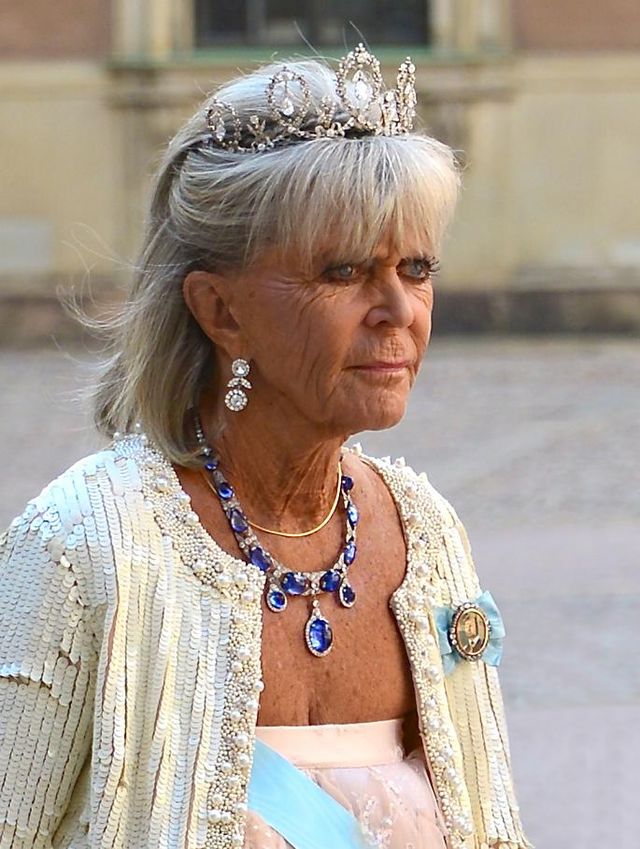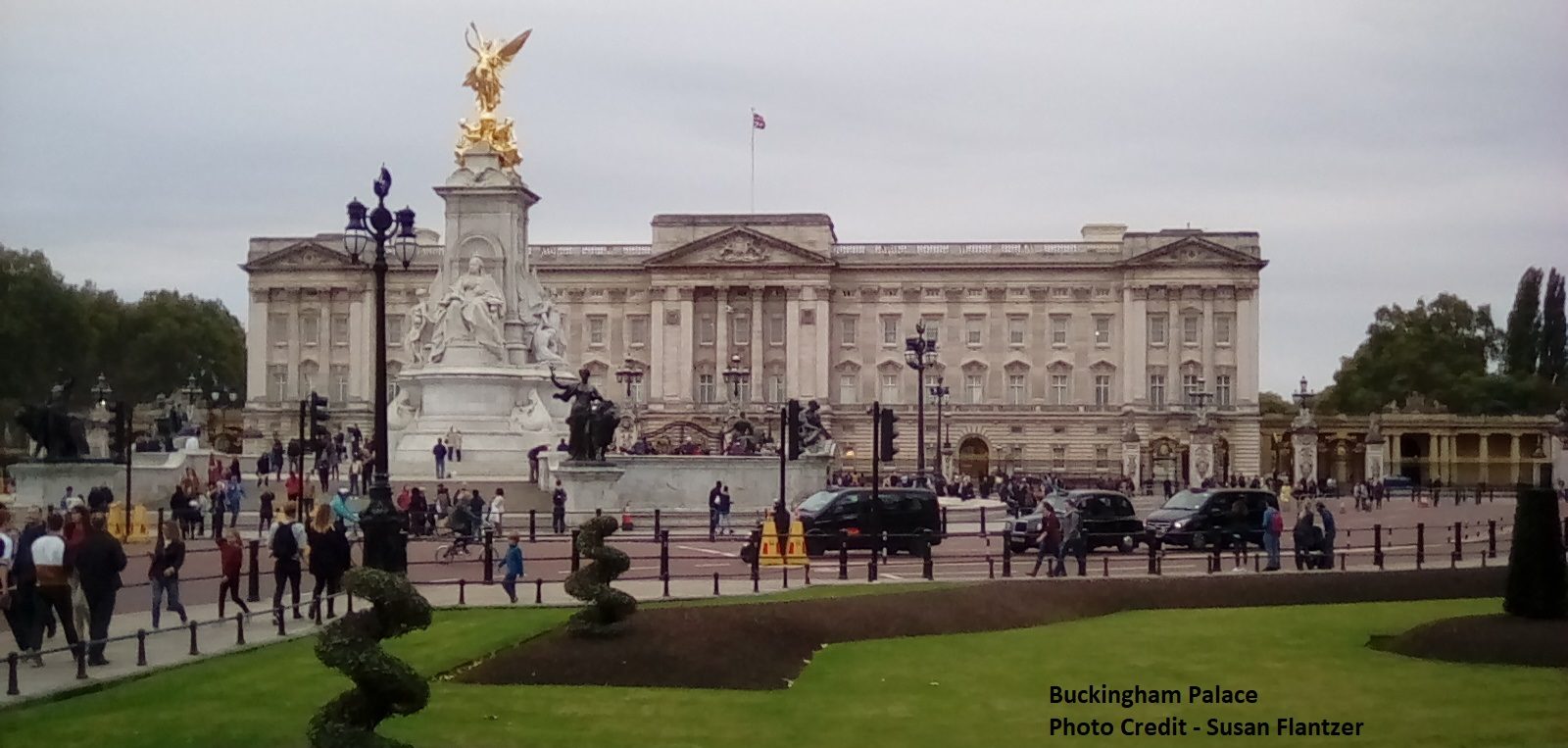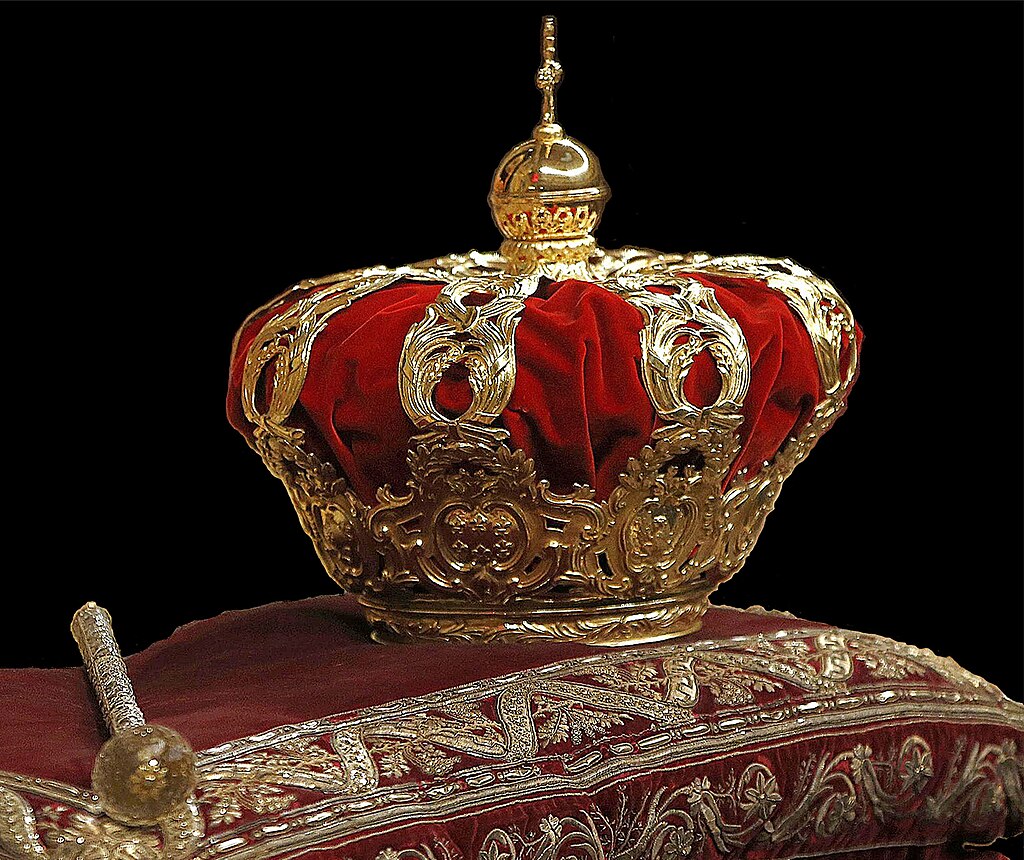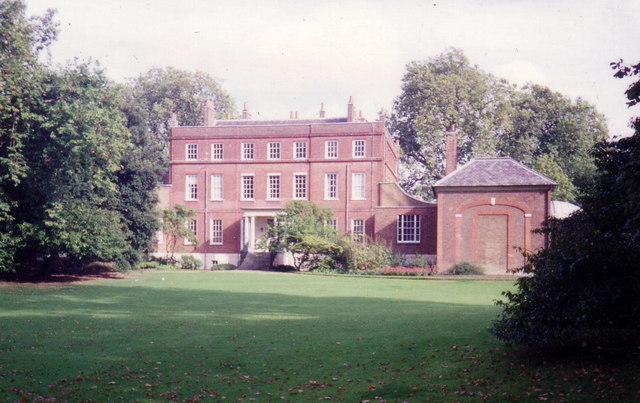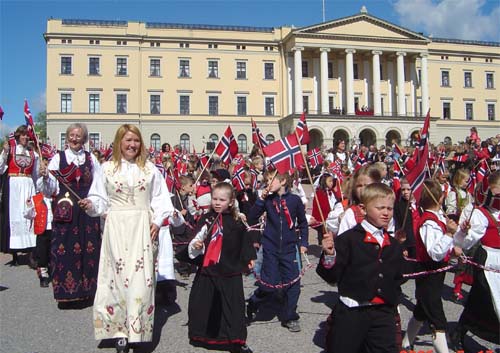by Susan Flantzer
© Unofficial Royalty 2024

Benediction of King Harald V and Queen Sonja at Nidaros Cathedral in Trondheim; Credit – Royal House of Norway
A Bit of History
The Kingdom of Norway was established in 872 as a merger of many small kingdoms. During the Kalmar Union from 1397 until 1523, Denmark, Sweden, and Norway were ruled together under one monarch until Danish rule was overthrown in a rebellion led by nobleman Gustav Vasa, who became King Gustav I of Sweden. From 1537 to 1814, Norway was a part of the Kingdom of Denmark-Norway, and from 1814 to 1905, it was in a personal union with the Kingdom of Sweden.
In 1905, when the union between Sweden and Norway was dissolved, the Norwegian government began searching for candidates to become King of Norway. Prince Carl of Denmark, the second son of King Frederik VIII of Denmark, was the overwhelming favorite because of his descent from prior Norwegian monarchs and the British connections of his wife Princess Maud, daughter of King Edward VII of the United Kingdom. Before accepting, Prince Carl insisted that the voices of the Norwegian people be heard regarding retaining a monarchy. Following a referendum with a 79% majority in favor, Prince Carl was formally offered, and then accepted the throne and reigned as King Haakon VII of Norway until he died in 1957.
********************
Accession
When the Norwegian Sovereign dies, the accession is automatic. The last Norwegian accession took place on January 17, 1991, when King Olav V died and his son immediately succeeded him as King Harald V. The Constitution of Norway requires the new Norwegian Sovereign to swear an oath before the Storting, the Norwegian legislature. If the Storting is not in session, the new Sovereign swears the oath before the Council of State and again before the Storting once it is in session.
On January 21, 1991, King Harald V swore an oath during a formal ceremony in the Storting. President of the Storting Jo Benkow read the announcement of King Olav V’s death before King Harald V swore the oath: “I solemnly swear to reign in the Kingdom of Norway in accordance with its Constitution and laws, so help me Almighty God.”
********************
History of Coronations
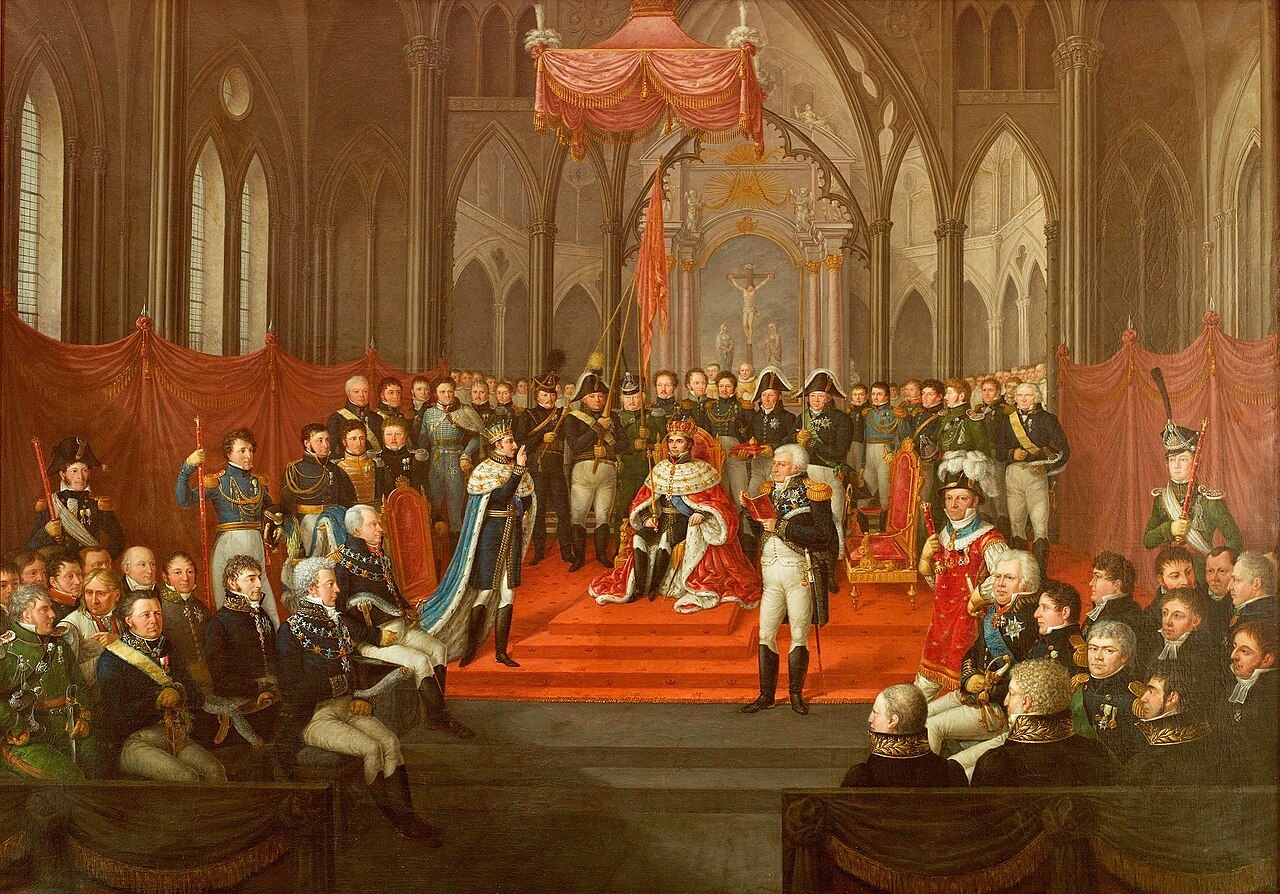
Coronation of King Karl III Johan of Norway in Nidaros Cathedral 1818; Credit – Wikipedia
The first coronation in Norway occurred in 1163 or 1164, in Bergen, then the capital of Norway, at Christ Church (Old Cathedral). Christ Church was razed to the ground In 1531, by Eske Bille, a Danish diplomat and statesman, and commander of the Bergenhus Fortress. Bille was famous for demolishing the churches in Bergen and became known by the nickname “Church Breaker”. Churches and other buildings in Bergen had to be removed to enable a better defense of Bergen and its port. When King Haakon V came to the throne in 1299, Norway’s capital was moved from Bergen to Oslo, which is still Norway’s capital. After 1299, some coronations were held in Oslo but most took place at Nidaros Cathedral in Trondheim.
During the Kalmar Union (1397 to 1523), when a single monarch ruled Denmark, Norway, and Sweden, the monarchs were crowned in all three monarchies. After the Kalmar Union was dissolved, Norway remained unified with Denmark under the King of Denmark until 1814. Throughout the Danish Union, the Kings of Denmark-Norway had one ceremony in Denmark in which the King placed the crown upon his own head and was anointed. During the Swedish Union (1814 – 1905), the 1814 Constitution of Norway required the monarch of Norway to be crowned in Nidaros Cathedral in Trondheim, Norway.
The first King of Sweden-Norway, King Karl II of Norway who was also King Carl XIII of Sweden, never visited Norway and was never crowned. When King Karl III Johan of Norway/King Carl XIV Johan of Sweden ascended the throne in 1818, the coronation at Nidaros Cathedral in Trondheim continued in accordance with the 1814 Constitution of Norway with him and his successors.

King Haakon VII and Queen Maud seated on their thrones during their coronation in 1906; Credit – By Municipal Archives of Trondheim from Trondheim, Norway – Kroningen i Trondhjem 1906Uploaded by Anne-Sophie Ofrim, CC BY 2.0, https://commons.wikimedia.org/w/index.php?curid=18901728
When the Swedish union was abolished in 1905, and Prince Carl of Denmark was elected King of Norway and reigned as King Haakon VII, he and his wife Queen Maud (born Princess Maud of Wales, the daughter of King Edward VII of the United Kingdom) were crowned at Nidaros Cathedral in Trondheim, in accordance with the 1814 Constitution of Norway. So far, this was the last coronation held in Norway.
********************
A Change
In 1908, just two years after the coronation of King Haakon VII and Queen Maud, the Storting, the Norwegian legislature, repealed the provision in the Constitution of Norway requiring a coronation with only two Storting members voting against the repeal. Many Norwegians felt that a coronation was undemocratic and archaic. Norwegian law does not expressly ban coronations but the Norwegian monarchs since the 1908 repeal have opted for a different ceremony, a benediction.
********************
History of the Benediction
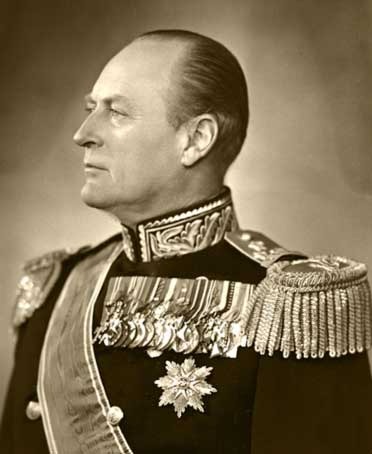
King Olav V of Norway; Credit – Wikipedia
When King Olav V came to the throne in 1957, upon the death of his father King Haakon VII, he desired to have a religious ceremony as he embarked on his roles as King of Norway and the Head of the Church of Norway. Olav proposed a ritual known in Norwegian as Signing til kongsgjerning – Blessing the King for His Reign – a benediction rite. There was and still is no constitutional prohibition against arranging a ceremony for a new monarch of Norway, even a coronation if any future monarch of Norway desires to have one.
King Olav played an active role in developing the Benediction, also called the Consecration. However, Prime Minister Einar Gerhardsen and his Government showed little enthusiasm for the Benediction. The Government decided that only three members of the Storting’s Presidium, a committee of six members chaired by the President of the Storting, three members of the Government, and the Chief Justice of the Supreme Court should attend the Benediction. However, Arne Fjellbu, Bishop of Nidaros sent a letter to all members of the Storting informing them that seating would be reserved for all those who wished to attend. Within a short time, most of the Storting members had accepted the invitation.
********************
King Olav V’s Benediction – June 22, 1958
King Olav V’s wife and first cousin, born Princess Märtha of Sweden, sadly died of cancer on April 5, 1954, so Olav came to the throne without a Queen Consort, and he never remarried. For his Benediction, Olav chose the date June 22, 1958, exactly 52 years after the coronation of his parents in the same cathedral, Nidaros Cathedral in Trondheim, Norway. The ceremony was carried live by radio throughout Norway.
Arne Fjellbu, Bishop of Nidaros and Johannes Smemo, Bishop of Oslo, who gave the sermon, officiated at the Benediction. The new ceremony retained some of the religious elements of earlier rites and eliminated elements considered to be undemocratic. There is no law preventing a coronation from occurring so any future monarch of Norway can choose to have one. During the ceremony, the Norwegian royal regalia was displayed but not worn.
King Olav V sat on the 1818 coronation throne in Nidaros Cathedral. Following the sermon, Olav knelt before the high altar. Bishop Fjellbu laid his hand on the king’s head and recited a special prayer of consecration and blessing which formed the climax of the ritual:
Eternal, Almighty God, Heavenly Father, we thank thee whose grace in need has always gone over our land in woeful and good times to this day. Hear, today, our king’s and our prayer. We pray thee, send thy grace to King Olav the Fifth, assist him by thy Spirit and give him wisdom and peace from thee that his reign be a benefit and a blessing on Norway’s land and people. Deceitful and burdensome days will come; may truth and goodness from thee be his power and gladness. Eternal, powerful God, bless our king, be thou always his Lord and his King and grant his House all good days in time and eternity. Amen.
**********************
Benediction of King Harald V and Queen Sonja – June 23, 1991
King Olav V died on January 17, 1991, and his son King Harald V succeeded him. King Harald V and his wife Queen Sonja, a commoner, born Sonja Haraldsen, expressed their desire to both participate in a Benediction ceremony like King Olav V’s. On June 23, 1991, their Benediction ceremony was held at Nidaros Cathedral in Trondheim, Norway, officiated by Finn Wagle, Bishop of Nidaros and Andreas Aarflot, Bishop of Oslo.

King Haakon VII and Queen Maud in 1906 with the Norwegian regalia; Credit – By Peder O. Aune, 1906 Uploaded by Anne-Sophie Ofrim, CC BY 2.0, https://commons.wikimedia.org/w/index.php?curid=23926801
The royal regalia was displayed during the ceremony but not worn. The King’s Crown and the Queen’s Crown were placed on either side of the high altar. The bishops met King Harald V and Queen Sonja as they entered the cathedral. Bishop Wagle greeted King Harald: “May the Lord bless your going in and your coming out now and for evermore.” King Harald V and Queen Sonja proceeded up the aisle and sat in the 1818 coronation thrones.
After scripture readings and the sermon, King Harald V knelt before the high altar. Bishop Wagle put his right hand on his head and said the consecration prayer which included: “Consecrate King Harald V, strengthen and lead him in his work as King of Norway. Let his service to the people and the Church be a blessing.”
Queen Sonja then came forward and knelt beside King Harald. Bishop Wagle lay his right hand on her head and said: “Let her work be in support of the King’s deed. Help her use abilities and forces for the joy and benefit of Norway’s country and people.”
Bishop Wagle then said a prayer over the kneeling King and Queen and turned and knelt at the high altar as the Royal Anthem, the Kongesangen, was sung:
God bless our good king!
Bless him with strength and courage
bless home and castle!
Guide him with your Spirit,
Forge with your strong Hand
Holy bonds of allegiance
Around people and king!
Loudly pledge men of Norway
Each in his calling, his station,
Loyalty to his king.
Loyal in life and death,
Courageous in war and distress,
Always our Norway obeyed
God and its king.
Bishop Wagle said a final blessing over the kneeling King and Queen: “The grace of our Lord Jesus Christ, the love of God, and the fellowship of the Holy Spirit, be with you. Amen.” The Lord Chamberlain then came forward as the King and Queen rose, and conducted them back to their coronation thrones.
This article is the intellectual property of Unofficial Royalty and is NOT TO BE COPIED, EDITED, OR POSTED IN ANY FORM ON ANOTHER WEBSITE under any circumstances. It is permissible to use a link that directs to Unofficial Royalty.
Works Cited
- Accession of the New Monarch in 1991. (2016). Royalcourt.no. https://www.royalcourt.no/nyhet.html?tid=131423&sek=27262
- Consecration. (2011). Royalcourt.no. https://www.royalcourt.no/artikkel.html?tid=35248&sek=35247
- The Consecration of King Harald and Queen Sonja. (2013). Royalcourt.no. https://www.royalcourt.no/artikkel.html?tid=28733&sek=27278
- The Consecration of King Olav V. (2007). Royalcourt.no. https://www.royalcourt.no/artikkel.html?tid=35246&sek=35244
- Wikipedia Contributors. (2024). Coronations in Norway. Wikipedia; Wikimedia Foundation.
- Wikipedia Contributors. (2024). Monarchy of Norway. Wikipedia; Wikimedia Foundation.
